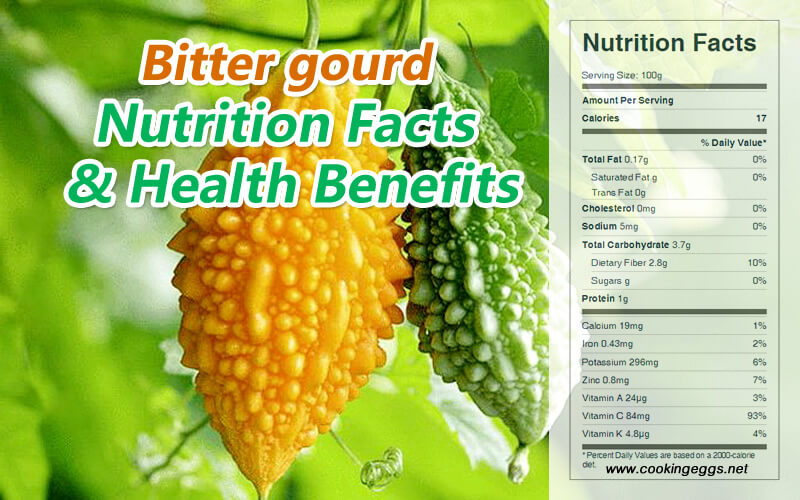Bitter Gourd Nutrition Facts & Health Benefits
Warning: A non-numeric value encountered in /www/wwwroot/www.cookingeggs.net/wp-content/plugins/nutrition-facts-label/nutrition-facts-label.php on line 384
Warning: A non-numeric value encountered in /www/wwwroot/www.cookingeggs.net/wp-content/plugins/nutrition-facts-label/nutrition-facts-label.php on line 384
The bitter gourd is a member of the Cucurbitaceae family and is also known as bitter melon, balsam pear, bitter squash, etc. The vegetable’s name is derived from its distinctive bitter taste. The fruit resembles a warty gourd or cucumber, with the young fruit being an emerald green color that turns orange-yellow when ripe.
Nutritional Value of Bitter Gourd
The bitter gourd contains 94% water, 3.7% carbohydrates, 1% protein, and negligible amounts of fat. They are a source of vitamins C and fiber, potassium, magnesium, calcium, manganese, sodium, iron, and phosphorus.
In a 100-gram reference amount, raw bitter gourd supplies 17 calories, 3.7 g carbohydrate, 1 g protein, 0.17 g fat, 84 mg vitamin C, 72 µg folate, 19 mg calcium, 0.43 mg iron, 17 mg magnesium, 31 mg phosphorus, 296 mg potassium, 5 mg sodium, and 0.08 mg manganese.
Other compounds found in bitter gourd that may contribute to its health benefits include other glycosides, antioxidants, carotenoids, flavanoids, and polyphenols. The cucurbutanoid compounds are the bioactive compounds in bitter gourd, contributing to its hypoglycemic properties.

Raw Bitter Gourd Nutrition Facts Label
Health Benefits of Bitter Gourd
Bitter gourd is used as a vegetable in many countries, but since time immemorial, it has also been used for therapy for numerous ailments, such as diabetes, obesity, hypertension, cancer, gastric ulcer, and many inflammatory diseases. Bitter gourd has numerous medicinal uses in treating fevers, gastrointestinal complaints, painful menstruation, skin conditions, and wound healing.
Bitter gourd is often used in folk medicine to treat diabetes, a significant number of studies have established the hypoglycemic of bitter gourd. It contains a number of compounds that have proven antidiabetic properties, including a compound known as charantin, insulin-like peptides, and alkaloids. They are reputed to have blood sugar-lowering effects. Science has pretty much confirmed the blood sugar lowering action of the fresh juice of the unripe bitter gourd. The research shows that bitter gourd has profound effects on lowering fasting blood glucose and increasing both liver and muscle glycogen stores.
Research has shown that bitter gourd has hypoglycemic and hypolipidemic effects. Bitter gourd contains active components such as saponin and plant sterols that may possibly influence lipid metabolism. Saponins have been shown to exhibit hypotriglyceridemic activity through the inhibition of triglyceride synthesis in the liver. The anti-obesity effects of bitter gourd are attributed to enhanced sympathetic activity and lipolytic processes as suggested by elevated plasma catecholamines and free fatty acids. increased mitochondrial transport of long-chain fatty acids and activity of acyl-coA dehydrogenase, a key enzyme in fatty acid oxidation. Additionally, these compounds may also regulate adipocytokine production, resulting in improved insulin sensitivity.
The bitter gourd exhibits anti-inflammatory properties. Bitter gourd's anti-inflammatory effect was thought to be due to linoleoyl and linoleoyl-lysophosphatidyl-choline. Bitter gourd was also shown to induce both intestinal and systematic anti-inflammatory responses both in vitro and in vivo by decreasing interleukin (IL)-7 secretion and the number of lymphocytes.
Fresh bitter gourd is a good source of vitamin C (93% of the DV). Vitamin C is an essential nutrient involved in the repair of tissue, the formation of collagen, and the enzymatic production of certain neurotransmitters. It is important for the immune system and also functions as an antioxidant.
In addition, bitter gourd is a source of flavonoids such as β-carotene, α-carotene, lutein, and zeaxanthin. It also contains a good amount of vitamin A. Together, these compounds help act as protective scavengers against oxygen-derived free radicals and reactive oxygen species that play a role in aging, cancer, and various disease processes.
Health Risk
Reported side effects include diarrhea, abdominal pain, fever, hypoglycemia, urinary incontinence, and chest pain. Symptoms are generally mild, do not require treatment, and resolve with rest.
Bitter gourd is contraindicated in pregnant women because it can induce bleeding, contractions, and miscarriage.